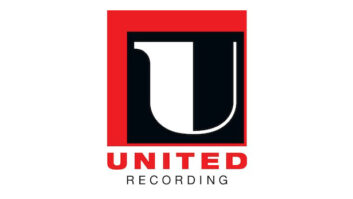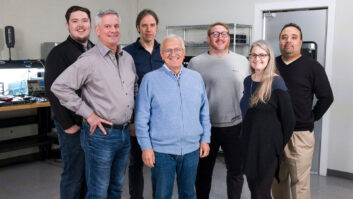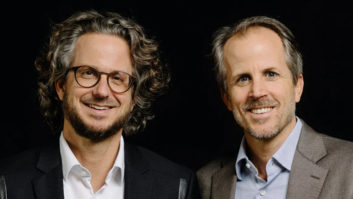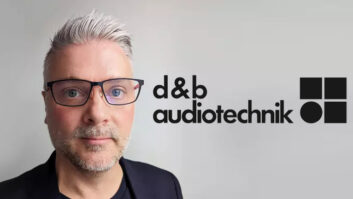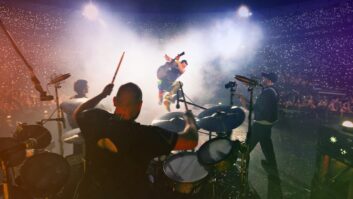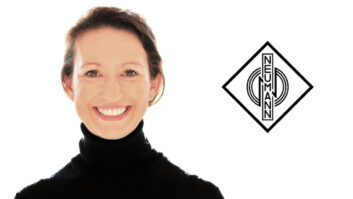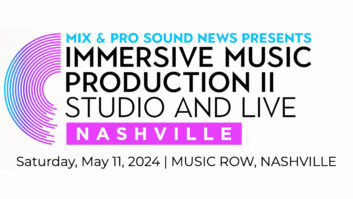Conceived by producer Paul O’Neill in the early Nineties as an album project, Trans- Siberian Orchestra (TSO) hit it big with an unlikely hybrid of progressive rock, classical standards and unabashedly sentimental Christmas music. The album project became a full-fledged holiday production, however, when TSO took to the road in 1999; by 2007, the extravaganza had morphed into simultaneous East and West Coast arena shows that go out every holiday season. Today, the tours each play five venues a week, with double shows on Friday and the weekend, for total of eight shows weekly.
Trans-Siberian Orchestra fields twin East and West Coast tours during the holiday season, both of which sport Clair I-5 line array systems. The twin productions—both carrying audio gear from Clair (Lititz, PA)—are amazingly complex. Daily, 18 trucks load-in to the venue at 6 a.m., racing against the clock before doors open at 2 p.m. “Anyone who reads your article is going to think that’s fiction,” said Jim Ragus, crew chief/system engineer on the East Coast edition. “It is not; we do it every single day. And we don’t have another set-up—this stuff will appear tomorrow in another city. As a guy that’s been slinging speakers for 30 years, it was an eye-opening experience when I first joined this tour four years ago—the magnitude of what is accomplished is staggering.”

Despite the non-stop pace, loadin and tear-down runs like a well-oiled machine. “I’ve been on much smaller shows where there’s a lot of drama, screaming and yelling in order to make it happen; this show just doesn’t have that—too many pros out here,” said East Coast monitor engineer Scott Fraser. Carrying staging, props, lights, sound, video, pyro and more lasers than Star Wars, those trucks are jammed to the gills. “Lots of tours, they have their Big Gag—we don’t have that,” said Fraser. “We’ve got six of them.”
Of course, for all the accouterments, the draw is the music, and supplying that on each production are a core team of a half-dozen musicians, multiple additional vocalists and local eight-piece string sections that play on multiple shows in their region. Mixing the 90-plus inputs coming off the stage nightly on the East Coast tour is Dave Wittman, best known for his work in the studio, having recorded the likes of Billy Idol, Kiss and Led Zeppelin, among others. When O’Neill put TSO on the road in 1999, he asked Wittman to man a FOH desk for the first time—back then, a Gamble, then later a Midas Heritage 3000— and the engineer has returned every year since. These days, Wittman oversees a DiGiCo SD7, because as the production has grown, so have his demands on the desk: “There’s only so many stereo modules you can replace in the Midas,” said Wittman, “so that’s how we ended up with the DiGiCo. It’s been really versatile and obviously it has way more room for expansion—if we ever add any more, we’re fine—so we’ve been cruising nicely on the SD7 now.”
While Wittman brought along outboard gear in the form of Lexicon reverbs and such for his first few tours with the console, he’s since switched over to using the desk’s internal effects. Meanwhile, Fraser—who looks after 117 inputs on his monitorworld SD7 between the musicians, talkback mics and so forth—has gone the opposite direction in recent times: “I actually use all of the reverbs available in a SD7; I don’t know how it’s possible but I did it, so now I actually have two outboard effects as well—a Lexicon PCM91 and a Yamaha SPX2000.”
Wittman engineered all of TSO’s albums, so he brings that experience to bear nightly when mixing the show: “Not having any other experience in live mixing, I just try to transfer my studio situation to the live experience. There are many factors involved in that—namely the acoustics of the arena—but my basic approach is still to make it sound like the record.”
Helping lay the foundation for that is a stage that’s less loud than it could be, considering the hard rock musical arrangements and plethora of musicians on hand. Key to the effort are a preponderance of in-ear monitors and instruments that are DI’d. “There’s not that many live microphones out there,” confirmed Fraser. “The vocal mics are Shure 58As and all of the main vocals are UHF-R wireless handhelds. The backline is regular Beta 58As. The drum kit’s a mix and match of some AKG 414s and Shure SM81s on the overheads and cymbals since the drums are electronic. Other than that, most of the inputs are directs—some of it’s Whirlwind, some of it’s custom-built by Clair.”
The TSO East Coast audio team (clockwise from left): Scott Fraser, monitor engineer; Dave Wittman, FOH engineer; Jim Ragus, crew chief/systems engineer; Rick Roman, System tech; Erik Swanson, monitor tech/RF tech; Jordan Turner, system tech. At stageside, Fraser tackles two-dozen in-ear mixes, along with six wedge mixes heard onstage via Clair CM22s in order to “get a feel and to thicken things up, plus some of the vocalists only use one in-ear. The string players aren’t using in-ears, so they get mixes out of Clair FF2s—little front fill speakers we have just to spill some sound up there.”

Bringing sound to the rest of the arena at 95 dB on average and peaking around 98 dB, is a large PA comprised of Clair I-5 line array boxes, supplemented by flown I-5B subs, all powered by Clair’s StakRaks— custom racks of Lab.gruppen PLM 20000Q amplifiers. “There’s no subs on the ground,” said Ragus, “which gives us the opportunity to have a nicely distributed low end that doesn’t hammer anybody down front. It’s allowed us to keep our volume at a really nice level; Dave is really good at making it sound powerful at obviously a very reasonable level, going for fullness instead of just sheer volume.”
That’s a very deliberate choice on Wittman’s part, as the engineer explained: “I’m a rock-and-roller from way back, so that’s the way I approach it, but we all want to keep it family-oriented here so that people of all ages will enjoy the show. You look out across the audience and it ranges from people who are over my age on down to little kids— and they’re having a great time. You know, that makes you feel good.”
The un-ironic, sincere vibe that permeates each night’s performance isn’t just for show, either; the cast and crew really mean it. Given the rigorous schedule (“I say this with all the love in my heart: It’s brutal!” laughed one crewmember), a steady gig at the end of the touring year isn’t the only enticement to come back again and again as most of the crew does. “I think that it’s a ‘family’ kind of thing,” admitted Fraser. “Between the East Coast and West Coast divisions of this show, there’s a lot of people. We all assemble in Omaha and do pre-production together, and a lot of us come back because we just enjoy working with this group of people. I’m back every year because I love it.”
Clair
clairglobal.com
Trans-Siberian Orchestra
trans-siberian.com
